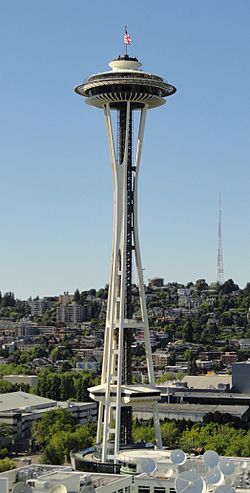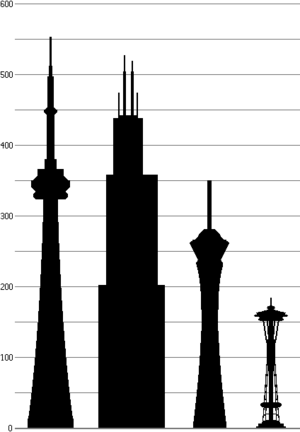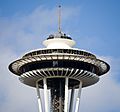Space Needle facts for kids
Quick facts for kids Space Needle |
|
|---|---|

The flag of the United States on the Space Needle on Independence Day, 2011
|
|
| General information | |
| Status | Complete |
| Type | Observation tower |
| Location | 400 Broad Street Seattle, Washington |
| Coordinates | 47°37′13″N 122°20′57″W / 47.6204°N 122.3491°W |
| Construction started | April 17, 1961 |
| Completed | December 8, 1961 |
| Opening | April 21, 1962 |
| Owner | Space Needle Corporation |
| Height | |
| Antenna spire | 184.41 m (605.0 ft) |
| Top floor | 158.12 m (518.8 ft) |
| Technical details | |
| Floor count | 6 |
| Lifts/elevators | 3 |
| Design and construction | |
| Architect | John Graham & Company |
| Structural engineer | John K. Minasian Victor Steinbrueck |
| Main contractor | Howard S. Wright Construction Co. |
The Space Needle is a tower in Seattle, Washington. It is at the Seattle Center. The Space Needle was built for the 1962 World's Fair. During this time, almost 20,000 people used the elevators every day. Over 2.3 million visitors came to the World Fair overall. The Space Needle is 605 feet (184 m) high and 138 feet (42 m) wide. It weighs 9,550 tons. When it was completed it was the tallest building to the west of the Mississippi River. It is built not to fall in wind up to 200 miles per hour (89 m/s) and earthquakes of up to 9.1 magnitude. This gives protection against an earthquake as powerful as the 1700 Cascadia earthquake. The tower also has 25 lightning rods on its roof to protect it against lightning.
The Space Needle has a deck at 520 feet (160 m), where people can look down and look at the view around them. It also has a gift shop with a rotating SkyCity restaurant at 500 feet (150 m). From the top of the Needle, the Downtown Seattle skyline, the Olympic and Cascade Mountains, Mount Rainier, Mount Baker, Elliott Bay and islands around it can be seen. Photographs of the Seattle skyline often show the Space Needle.
Visitors can reach the top of the Space Needle by using elevators. These elevators travel at 10 miles per hour (4.5 m/s). The trip to the top takes 41 seconds. Some tourists wait in hour-long lines so that they can go to the top of the tower. On windy days, the elevators are slowed down to a 5 miles per hour (2.2 m/s). The Space Needle was made a historic landmark on April 19, 1999, by the City's Landmarks Preservation Board.
Contents
Architecture
The architecture of the Space Needle is the result of a compromise between the designs of two men, Edward E. Carlson and John Graham, Jr. The two leading ideas for the World Fair involved businessman Edward E. Carlson's sketch of a giant balloon tethered to the ground (the gently sloping base) and architect John Graham's concept of a flying saucer (the halo that houses the restaurant and observation deck). Victor Steinbrueck introduced the hourglass profile of the tower. The Space Needle was built to withstand wind speeds of 200 mph (320 km/h), double the requirements in the building code of 1962. The 6.8 Mw Nisqually earthquake jolted the Needle enough in 2001 for water to slosh out of the toilets in the restrooms. The Space Needle will not sustain serious structural damage during earthquakes of magnitudes below 9.1. Also made to withstand Category 5 hurricane-force winds, the Space Needle sways only 1 in (25 mm) per 10 mph (16 km/h) of wind speed.
For decades, the hovering disk of the Space Needle was home to 2 restaurants 500 ft (150 m) above the ground: the Space Needle Restaurant, which was originally named Eye of the Needle, and Emerald Suite. These were closed in 2000 to make way for SkyCity, a larger restaurant that features Pacific Northwest cuisine. SkyCity rotates 360 degrees in exactly forty-seven minutes. In 1993, the elevators were replaced with new computerized versions. The new elevators descend at a rate of 10 mph (16 km/h).
On December 31, 1999, a powerful beam of light was unveiled for the first time. Called the Legacy Light or Skybeam, it is powered by lamps that total 85 million candela shining skyward from the top of the Space Needle to honor national holidays and special occasions in Seattle. The concept of this beam was derived from the official 1962 World's Fair poster, which depicted such a light source although none was incorporated into the original design. It is somewhat controversial because of the light pollution it creates. Originally planned to be turned on 75 nights per year, it has generally been used fewer than a dozen times per year. It did remain lit for eleven days in a row from September 11, 2001, to September 22, 2001, in response to the September 11, 2001 attacks.
A 1962 Seattle World's Fair poster showed a grand spiral entryway leading to the elevator that was ultimately omitted from final building plans. The stairway was eventually added as part of the Pavilion and Spacebase remodel in June 2000. The main stairwell has 848 steps from the basement to the top of the observation deck. At approximately 605 ft (184 m), the Space Needle was the tallest building west of the Mississippi River at the time it was built by Howard S. Wright Construction Co., but is now dwarfed by other structures along the Seattle skyline, among them the Columbia Center, at 967 ft (295 m). Unlike many other similar structures, such as the CN Tower in Toronto, the Space Needle is not used for broadcasting purposes.
Related pages
Images for kids
See also
 In Spanish: Space Needle para niños
In Spanish: Space Needle para niños














